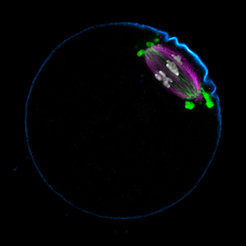What egg cells do differently when dividing
When a new life begins, only half of the genetic information is provided by the egg, the other half comes from the sperm. To this end, the egg has to eliminate half of its chromosomes. This happens during a specialized cell division, called meiosis. This process, however, is error-prone: It can happen that too many or too few chromosomes remain in the egg, resulting in an embryo whose cells have an incorrect number of chromosomes. Such embryos often die early in pregnancy, or develop into humans with a chromosomal disorder such as Down syndrome.

A complex cellular machine, the spindle, ensures that the chromosomes in the egg are distributed correctly. It consists of protein fibers that fan out towards each other from two spindle poles. The spindle first captures the chromosome pairs and arranges them in one plane. In the next step, half of the chromosomes are pulled to each spindle pole. Mechanistically, this process resembles the distribution of chromosomes during the division of normal body cells.
To distribute the chromosomes correctly, the cell must control exactly how the spindle is set up and how it functions. In most body cells, centrosomes fulfil this task. They are special spindle organizing centers consisting of multiple proteins, which are located at the two spindle poles. However, eggs do not have centrosomes. How they manage to control spindle assembly has so far been largely unclear.
A team of researchers led by Melina Schuh, Director at the MPI for Biophysical Chemistry, has now discovered a previously unknown structure in the eggs of mice and other mammals. This structure is essential to organize the spindle, ensuring that the correct number of chromosomes ends up in the egg so that a healthy embryo can develop.
Structure with the properties of a liquid
“The egg contains many proteins that are normally found at centrosomes. So we were wondering how these proteins function in egg cells, where centrosomes are absent,” Schuh explains. “To our surprise, we observed under the microscope that 19 proteins localized to an unusual structure in the spindle region. This structure has a very special morphology. It resembles a liquid which permeates the spindle poles and forms droplet-shaped protrusions that extend beyond the spindle.”
Chromosome segregation in a mouse egg
The newly discovered structure has unusual properties, as well: Unlike many other structures in a cell, it is not surrounded by a membrane barrier separating it from its environment. Instead, it appears to form via phase separation, explains Chun So, PhD student in Schuh’s lab: “One might compare this to oil that does not mix with water but forms its own phase. Moreover, the structure behaves like a liquid: Individual droplets can fuse and the proteins contained in the structure can freely diffuse.” The cell biologists therefore termed the structure the liquid-like spindle domain (LISD).
“We think that the LISD helps to control the local concentration of spindle proteins in eggs. It sequesters many spindle-related factors in proximity of the spindle,” says Bianka Seres, a former PhD student in Schuh's team. “It could thereby help to ensure that precisely the right dose of proteins is available to form the spindle. This could be particularly important in eggs, which are larger than most other cells.”
The same proteins used differently
The LISD seems to be very important for eggs when it comes to chromosome segregation: When the researchers disrupted the LISD, the regulatory proteins were dispersed throughout the cell and spindles could no longer form properly. As a result, most eggs failed to distribute the chromosomes correctly.
“It appears that mammalian egg cells use the same proteins as normal body cells to assemble the meiotic spindle, but organize these proteins in a surprisingly different way,” Schuh summarizes. “It will be interesting to investigate if disturbances in the LISD also occur naturally, which could contribute to female infertility.” (fk)












